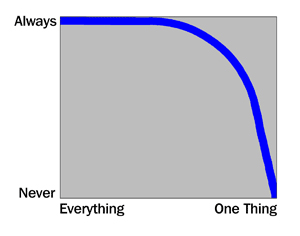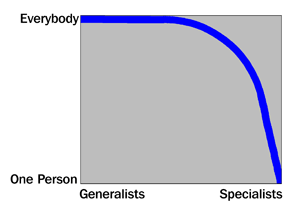
NPPA Independent Photographers Toolkit
Advertising Photographers of America Business Manual
Common Cents Column On The Cost of Doing Business
NPPA Online Discussion Group Instructions
Portions of this column were originally written for the January-February 2012 edition of News Photographer Magazine.
Mark Loundy is a media producer and consultant based in San Jose, California. Full bio.
The opinions in this article are those of the author alone and do not necessarily represent the official views of the National Press Photographers Association.
By Mark Loundy
"The slow one now, Will later be fast"
— Bob Dylan, The Times They Are A-Changin'
"I cannot believe that I have a Twitter account," wrote Managing Editor Steve Henson of The Pueblo (Colo) Chieftain. Henson had the considerable cajones to publically admit that he was actually not a "Social Media Guru." Henson explained to his blog readers how he understood Twitter works. At the end he wrote. "Or something like that. I'm still trying to figure it out." One of the things that Henson does get is that there are lots of talented journalists who don't understand the enormous changes in the news industry.
 One of the misconceptions about the technological advances of the past couple of decades is that journalism has fundamentally changed. It hasn't. Although distribution and tools have changed radically, the basic goals and principles of the past century have not.
One of the misconceptions about the technological advances of the past couple of decades is that journalism has fundamentally changed. It hasn't. Although distribution and tools have changed radically, the basic goals and principles of the past century have not.
This sort of technology shift has happened scores of times over the decades with similar complaints and criticisms. Do you remember all of the professional typesetters talking about all the crappy work done with desktop publishing software? Do you even know a professional typesetter anymore?
In fact, what we're doing is re-ordering and re-prioritizing the tools to meet long-underserved demands of our customers.
During the past century, journalism has consisted of:The medium has fractured from words and still images distributed on print with a daily deadline into (among other things):
While this seems like a whole new set of skills it's really no different from a carpenter moving from peg joints to a nail gun and a Sawzall®. The principles of strong construction and concern for the end user have not changed.
Journalists
If you've been a skilled "old school" journalist, you have all the instincts you need to move into the future. If you managed the switch from typewriters to VDTs, you can learn tweeting, blogging and linking. If you know how to work a source on the phone or on the next barstool, social media will be a natural thing. If you survived the move from film to digital, you know more than you think you do about video.
What is changing are journalists' typical days. No longer will they be using the same tool for every task. Some projects will still call for specialists, but all journalists need to be conversant in most of the tools on the shelf.
I've created a chart to illustrate how often journalists will be called upon to "do it all" and how often they'll be able to specialize. [figure1]

It should not be news that full-time professional photojournalism is dying. Shooters have become the custom cabinetmakers of visual journalism. The new name for them will be "journalist." The term "multimedia" will vanish because "multi" will be the standard way to get the job done. A photographer rolling to a routine spot-news assignment will understand that they will be responsible for both words and visual/audio media.
Columnists won't be able to file their piece and then hand-in a photo assignment. Most of the time, they'll be expected to make a good image or shoot good video on their own.
Reporters will conduct their interviews with the understanding that they'll be editing the audio for publication.
Because of the immediacy of the new tools, journalists who have traditionally worked in print, now have to think more like broadcast journalists. The York Daily Record's Randy Parker put it this way: "Should news break at 8 a.m., print is just about the furthest thing from our minds. We have 12 to 16 hours from that time before we need to wrap-up our efforts for print. But we have audiences on other platforms who need information by 8:05 a.m."
Even in situations that allow specializing, everybody is going to have to step-up their game. Reporters now have to think not only in long form and short form, but in traditionally edited pieces and in real-time publication (tweeting.) Because of the revolution in the ease of creating video, photographers now have to think more as filmmakers. Because of the two-way nature of the Internet, journalists must be accustomed to collaborating with the public from the beginning of the process.
And it is a process. It's important to stop thinking of journalism as a series of one-off projects. Stories are updated, corrected and discussed — essentially forever. Journalists create and nurture ongoing relationships with their stories and their readers.
Newsrooms
Managers with medium-to-large staffs will follow a staffing curve similar to Figure 1, above. They will have to balance their available staffing levels between Generalists (everybody) and Specialists (few.)
[figure2]

Managers would do well to read Jill Geisler's "Meet 12 great employees to toast in 2012." In her Poynter blog, Geisler talks about ways for managers to avoid typical pitfalls by describing a dozen staffer "types" and how to work with them. Example:
"3. The Boundary Spanner: Not the usual 'BS-er,' this one makes useful connections all across the organization. The Boundary Spanner builds influence by getting to know people whose roles and responsibilities vary greatly from hers. She finds ways to support those people and build networks that result in reciprocity.
"Your management challenge: Fly cover for your Boundary Spanner. Make certain you connect with the leaders of the other departments (especially if they are turf-protective) so her relationship-building is understood and valued."
The fundamental pieces of the craft have not changed, but the mindset of its practitioners must. As Digital First Media's Director of Community Engagement Steve Buttry wrote. "And traditional journalism skills still matter. I'm not very patient with curmudgeons, but I'll be more patient with someone whose reporting, writing, editing, photography or design skills are outstanding than with someone who's just pretty good at traditional skills. But that patience is wearing thin."
But I think that Record-Journal Publishing Company's New Media Specialist Alex Martin says it best, "That's one of the things I think is missing in journalism today — passion. There is far too much complacency and indifference. Readers want to know what is going on right now, not tomorrow morning. Our job as journalists is to get relevant and important information to the reader as accurately as we possibly can and as soon as we possibly can. When news breaks, journalists have the duty and privilege to act as the intermediary between the readers and the information they need. That's an incredible responsibility."